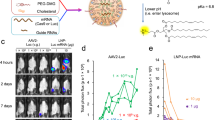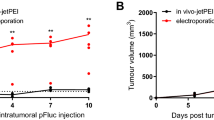Abstract
The immune response is modulated by genetic adjuvants using plasmid vectors expressing cytokines. Skeletal muscle can express a foreign gene intramuscularly administered via a needle injection, and the potential of muscle as a target tissue for somatic gene therapy in treating cancer has been explored. In the present study, we investigated the efficacy of particle-mediated intramuscular transfection modified with a local anesthetic agent, bupivacaine, on luciferase and green fluorescent protein. The results indicate that these proteins are more efficiently expressed and persist longer in muscle modified in this way compared with the needle-injection method. Using an established rat sarcoma model, particle-mediated intramuscular gene-gun therapy with a combination of IL-12 and IL-18 cDNA was conducted. Growth of the distant sarcoma was significantly inhibited by particle-mediated intramuscular combination gene therapy, and the survival rate was also improved. Furthermore, the combination gene-gun therapy maintained significant levels of interferon-γ and induced a high activity of tumor-specific cytotoxic T lymphocytes. These results suggest that the sustained local delivery of IL-12 and IL-18 cDNA using intramuscular gene-gun therapy modified with bupivacaine can induce long-term antitumor immunity, and can provide the great advantage of inhibiting the disseminated tumor.
This is a preview of subscription content, access via your institution
Access options
Subscribe to this journal
Receive 12 print issues and online access
$259.00 per year
only $21.58 per issue
Buy this article
- Purchase on Springer Link
- Instant access to full article PDF
Prices may be subject to local taxes which are calculated during checkout







Similar content being viewed by others
References
Donnelly JJ, Ulmer JB, Shiver JW, et al. DNA vaccines. Annu Rev Immunol. 1997;15:617–648.
Agha-Mohammadi S, Lotze MT . Immunomodulation of cancer: potential use of selectively replicating agents. J Clin Invest. 2000;105:1173–1176.
Wolff JA, Malone RW, Williams P, et al. Direct gene transfer into mouse muscle in vivo. Science. 1990;247:1465–1468.
Prud'homme GJ, Lawson BR, Chang Y, et al. Immunotherapeutic gene transfer into muscle. Trends Immunol. 2001;22:149–155.
Wells DJ . Improved gene transfer by direct plasmid injection associated with regeneration in mouse skeletal muscle. FEBS Lett. 1993;332:179–182.
Danko I, Fritz JD, Jiao S, et al. Pharmacological enhancement of in vivo foreign gene expression in muscle. Gene Therapy. 1994;1:114–121.
Wolff JA, Ludtke JJ, Acsadi G, et al. Long-term persistence of plasmid DNA and foreign gene expression in mouse muscle. Hum Mol Genet. 1992;6:363–369.
Cheng L, Ziegelhoffer PR, Yang NS . In vivo promoter activity and transgene expression in mammalian somatic tissues evaluated using particle bombardment. Proc Natl Acad Sci USA. 1993;90:4455–4459.
Yoshida Y, Kobayashi E, Endo H, et al. Introduction of DNA into rat liver with a hand-held gene gun: distribution of the expressed enzyme, [32P] DNA, and Ca2+ flux. Biocem Biophys Res Commun. 1997;234:695–700.
Hosoya Y, Kobayashi E, Yoshida Y, et al. Introduction of cytokine genes into rat solid neoplasms with a hand-held gene gun. Effect of IL-12 plus TNF-alpha gene transfection on subcutaneous tumor. Ann Cancer Res Ther. 1998;7:39–42.
Yang NS, Sun WH . Gene gun and other non-viral approaches for cancer gene therapy. Nat Med. 1995;1:481–483.
Rakhmilevich AL, Turner J, Ford MJ, et al. Gene gun-mediated skin transfection with interleukin 12 gene results in regression of established primary and metastatic murine tumors. Proc Natl Acad Sci USA. 1996;93:6291–6296.
Sun WH, Burkholder JK, Sun J, et al. In vivo cytokine gene transfer by gene gun reduces tumor growth in mice. Proc Natl Acad Sci USA. 1995;92:2889–2893.
Mahvi DM, Burkholder JK, Turner J, et al. Particle-mediated gene transfer of granulocyte-macrophage colony-stimulating factor cDNA to tumor cells: implications for a clinically relevant tumor vaccine. Hum Gene Ther. 1996;7:1535–1543.
Dilloo D, Bacon K, Holden W, et al. Combined chemokine and cytokine gene transfer enhances antitumor immunity. Nat Med. 1996;2:1090–1095.
Roth JA, Cristiano RJ . Gene therapy for cancer: what have we done and where are we going? J Natl Cancer Inst. 1997;89:21–39.
Gilboa E . Immunotherapy of cancer with genetically modified tumor vaccines. Semin Oncol. 1996;23:101–107.
Brunda MJ, Luistro L, Warrier RR, et al. Antitumor and antimetastatic activity of interleukin 12 against murine tumors. J Exp Med. 1993;178:1223–1230.
Tahara H, Zhe HJ, Storkus WJ, et al. Fibroblasts genetically engineered to secrete interleukin 12 can suppress tumor growth and induce antitumor immunity to a murine melanoma in vivo. Cancer Res. 1994;54:182–189.
Nastala CL, Edington HD, McKinney TG, et al. Recombinant IL-12 administration induces tumor regression in association with IFN-gamma production. J Immunol. 1994;153:1697–1706.
Tannenbaum CS, Wicker N, Armstrong D, et al. Cytokine and chemokine expression in tumors of mice receiving systemic therapy with IL-12. J Immunol. 1996;156:693–699.
Manetti R, Parronchi P, Giudizi MG et al. Natural killer cell stimulatory factor (interleukin 12 [IL-12]) induces T helper type 1 (Th1)-specific immune responses and inhibits the development of IL-4-producing Th cells. J Exp Med. 1993;177:1199–1204.
Hsieh CS, Macatonia SE, Tripp CS, et al. Development of TH1 CD4+ T cells through IL-12 produced by Listeria-induced macrophages. Science. 1993;260:547–549.
Martinotti A, Stoppacciaro A, Vagliani M, et al. CD4 T cells inhibit in vivo the CD8-mediated immune response against murine colon carcinoma cells transduced with interleukin-12 genes. Eur J Immunol. 1995;25:137–146.
Tsung K, Meko JB, Peplinski GR, et al. IL-12 induces T helper 1-directed antitumor response. J Immunol. 1997;158:3359–3365.
Cui J, Shin T, Kawano T, et al. Requirement for Valpha14 NKT cells in IL-12-mediated rejection of tumors. Science. 1997;278:1623–1626.
Brunda MJ, Luistro L, Hendrzak JA, et al. Role of interferon-gamma in mediating the antitumor efficacy of interleukin-12. J Immunother Emphasis Tumor Immunol. 1995;17:71–77.
Okamura H, Nagata K, Komatsu T, et al. A novel costimulatory factor for gamma interferon induction found in the livers of mice causes endotoxic shock. Infect Immunol. 1995;63:3966–3972.
Okamura H, Tsutsui H, Komatsu T, et al. Cloning of a new cytokine that induces IFN-gamma production by T cells. Nature. 1995;378:88–91.
Kohno K, Kataoka J, Ohtsuki T, et al. IFN-gamma-inducing factor (IGIF) is a costimulatory factor on the activation of Th1 but not Th2 cells[,] and exerts its effect independently of IL-12. J Immunol. 1997;158:1541–1550.
Ushio S, Namba M, Okura T, et al. Cloning of the cDNA for human IFN-gamma-inducing factor, expression in Escherichia coli, and studies on the biologic activities of the protein. J Immunol. 1996;156:4274–4279.
Micallef MJ, Ohtsuki T, Kohno K, et al. Interferon-gamma-inducing factor enhances T helper 1 cytokine production by stimulated human T cells: synergism with interleukin-12 for interferon-gamma production. Eur J Immunol. 1996;26:1647–1651.
Dao T, Ohashi K, Kayano T, et al. Interferon-gamma-inducing factor, a novel cytokine, enhances Fas ligand-mediated cytotoxicity of murine T helper 1 cells. Cell Immunol. 1996;173:230–235.
Tsutsui H, Nakanishi K, Matsui K, et al. IFN-gamma-inducing factor up-regulates Fas ligand-mediated cytotoxic activity of murine natural killer cell clones. J Immunol. 1996;157:3967–3973.
Dao T, Mehal WZ, Crispe IN . IL-18 augments perforin-dependent cytotoxicity of liver NK-T cells. J Immunol. 1998;161:2217–2222.
Ghayur T, Banerjee S, Hugunin M, et al. Caspase-1 processes IFN-gamma-inducing factor and regulates LPS-induced IFN-gamma production. Nature. 1997;386:619–623.
Gu Y, Kuida K, Tsutsui H, et al. Activation of interferon-gamma inducing factor mediated by interleukin-1beta converting enzyme. Science. 1997;275:206–209.
Ahn HJ, Maruo S, Tomura M, et al. A mechanism underlying synergy between IL-12 and IFN-gamma-inducing factor in enhanced production of IFN-gamma. J Immunol. 1997;159:2125–2131.
Osaki T, Peron JM, Cai Q, et al. IFN-gamma-inducing factor/IL-18 administration mediates IFN-gamma- and IL-12-independent antitumor effects. J Immunol. 1998;160:1742–1749.
Coughlin CM, Salhany KE, Wysocka M, et al. Interleukin-12 and interleukin-18 synergistically induce murine tumor regression which involves inhibition of angiogenesis. J Clin Invest. 1998;101:1441–1452.
Oshikawa K, Shi F, Rakhmilevich AL, et al. Synergistic inhibition of tumor growth in a murine mammary adenocarcinoma model by combinational gene therapy using IL-12, pro-IL-18, and IL-1beta converting enzyme cDNA. Proc Natl Acad Sci USA. 1999;96:13351–13356.
Gately MK, Warrier RR, Honasoge S, et al. Administration of recombinant IL-12 to normal mice enhances cytolytic lymphocyte activity and induces production of IFN-gamma in vivo. Int Immunol. 1994;6:157–167.
Orange JS, Salazar-Mather TP, Opal SM, et al. Mechanism of interleukin 12-mediated toxicities during experimental viral infections: role of tumor necrosis factor and glucocorticoids. J Exp Med. 1995;181:901–914.
Yamasaki M, Hashiguchi N, Tsukamoto T, et al. Variant form of green and blue fluorescent proteins adapted for use in mammalian cells. Bioimages. 1998;6:1–7.
Wang J, Murakami T, Hakamata Y, et al. Gene gun-mediated oral mucosal transfer of interleukin 12 cDNA coupled with an irradiated melanoma vaccine in a hamster model: Successful treatment of oral melanoma and distant skin lesion. Cancer Gene Ther. 2001;8:705–712.
Murakami T, Hirai H, Suzuki T, et al. HTLV-1 Tax enhances NF-kappa B2 expression and binds to the products p52 and p100, but does not suppress the inhibitory function of p100. Virology. 1995;206:1066–1074.
Benoit PW, Belt WD . Destruction and regeneration of skeletal muscle after treatment with a local anaesthetic, bupivacaine (Marcaine). J Anat. 1970;107:547–556.
Seale P, Asakura A, Rudnicki MA . The potential of muscle stem cells. Dev Cell. 2001;1:333–342.
Alameddine HS, Hantai D, Dehaupas M, et al. Role of persisting basement membrane in the reorganization of myofibres originating from myogenic cell grafts in the rat. Neuromuscul Disord. 1991;1:143–152.
Hanna E, Zhang X, Woodlis J, et al. Intramuscular electroporation delivery of IL-12 gene for treatment of squamous cell carcinoma located at distant site. Cancer Gene Ther. 2001;8:151–157.
Li S, Zhang X, Xia X, et al. Intramuscular electropora-tion delivery of IFN-alpha gene therapy for inhibition of tumor growth located at a distant site. Gene Ther. 2001;8:400–407.
Kobayashi M, Fitz L, Ryan M, et al. Identification and purification of natural killer cell stimulatory factor (NKSF), a cytokine with multiple biologic effects on human lymphocytes. J Exp Med. 1989;170:827–845.
D'Andrea A, Rengaraju M, Valiante NM, et al. Production of natural killer cell stimulatory factor (interleukin 12) by peripheral blood mononuclear cells. J Exp Med. 1992;176:1387–1398.
Acknowledgements
We thank Dr T Osumi (Himeji Institute of Technology, Hyogo, Japan) for donating a GFP plasmid, phGFP-105-C1; Dr S Wolf (the Genetic Institute, Cambridge, MA) for donating a murine IL-12 expression plasmid, pCAGGS-IL-12, Dr K Oshikawa (Jichi Medical School, Tochigi, Japan) for donating mouse pro-IL-18 and ICE plasmids), and Dr Y Matsumoto (Tokyo Metropolitan Institute for Neuroscience, Tokyo, Japan) for donating the OX35 and OX8 hybridoma cells. We greatly appreciate the skillful technical assistance of Ms Kyoko Okamoto and Ms Noriko Hayashi. This work was supported by a grant from the Ministry of Education, Culture, Sports, Science, and Technology of Japan.
Author information
Authors and Affiliations
Corresponding author
Rights and permissions
About this article
Cite this article
Ajiki, T., Murakami, T., Kobayashi, Y. et al. Long-lasting gene expression by particle-mediated intramuscular transfection modified with bupivacaine: combinatorial gene therapy with IL-12 and IL-18 cDNA against rat sarcoma at a distant site. Cancer Gene Ther 10, 318–329 (2003). https://doi.org/10.1038/sj.cgt.7700575
Received:
Published:
Issue Date:
DOI: https://doi.org/10.1038/sj.cgt.7700575
Keywords
This article is cited by
-
Transcriptional Modulation Using HDACi Depsipeptide Promotes Immune Cell-Mediated Tumor Destruction of Murine B16 Melanoma
Journal of Investigative Dermatology (2008)
-
Naked plasmid DNA transfer to the porcine liver using rapid injection with large volume
Gene Therapy (2006)
-
Gene transfer of pro-IL-18 and IL-1β converting enzyme cDNA induces potent antitumor effects in L1210 cells
Leukemia (2004)



